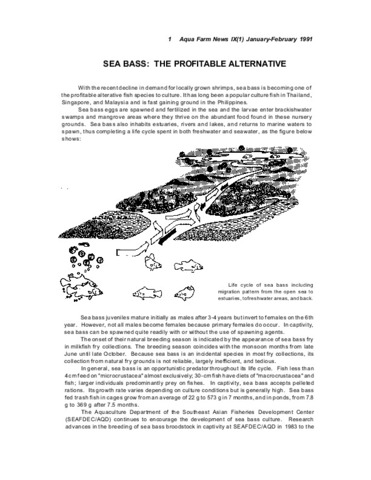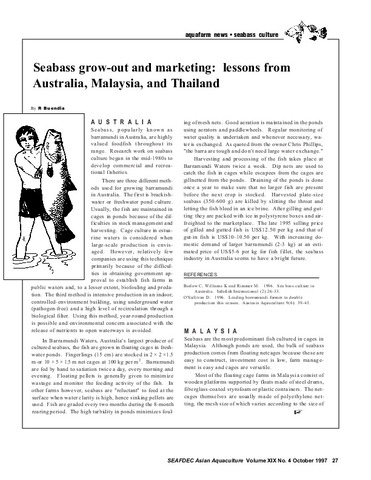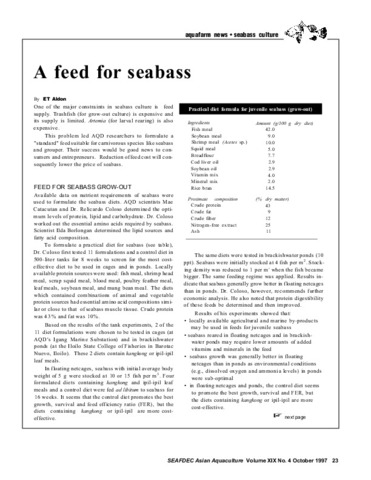Nursery rearing of the Asian sea bass, Lates calcarifer, fry in illuminated floating net cages with different feeding regimes and stocking densities
- Global styles
- MLA
- Vancouver
- Elsevier - Harvard
- APA
- Help

View/
Date
1996Page views
2,021ASFA keyword
AGROVOC keyword
Taxonomic term
Metadata
Show full item record
Share
Abstract
Successful rearing of hatchery-reared sea bass, Lates calcarifer, fry in illuminated floating cages was demonstrated in a 42-day experiment. Three feeding regimes, i.e. natural zooplankton (NZ) + minced fish flesh (MFF), NZ alone, or MFF alone and two stocking densities (600 and 1 200 individuals m2) were tested in a 3 × 2 factorial experiment. Fish reared in unlit cages and fed MFF alone during daytime served as the control. Results showed that no interaction existed between stocking density and feeding regime and that the two stocking densities used did not influence fish growth in terms of mean final body size. In general, sea bass reared in lit cages (NZ + MFF and NZ) grew and survived better than the control fish (MFF). However, fish reared under NZ + MFF feeding regime had the highest final mean total length (TL, 42.1 mm) and body weight (BW, 1 311.8 mg) followed by fish reared under NZ feeding regime (mean TL = 26 mm, BW = 415 mg). Fish in the unlit control cages exhibited the poorest growth (final mean TL and BW: 26 mm and 277.6 mg BW). Furthermore, specific growth rates (range: 5.7–8.5% day−1) of fish in lit cages were significantly better than those of fish in the unlit control cages (mean: 3% day−1). Percentage survival (38%) of fish stocked at 600 m−2 density and fed NZ was not significantly different from fish in the NZ + MFF feeding regime. However, increasing the density to 1 200 ind. m−2 tended to significantly decrease percentage survival (20%) of fish with NZ feeding. Fish reared in the unlit control cages had the poorest survival of 13–14%. The high percentage composition by number (CN, 88%) of copepods in the stomachs of sea bass fry fed on NZ alone and the equally high percentage feeding incidence (94%) indicated that fish fed sufficiently on natural zooplankton. Supplemental feed using minced fish flesh contributed about 43–59% of the fish diet in addition to natural zooplankton.
Suggested Citation
Fermin, A. C., Bolivar, M. E. C., & Gaitan, A. (1996). Nursery rearing of the Asian sea bass, Lates calcarifer, fry in illuminated floating net cages with different feeding regimes and stocking densities. Aquatic Living Resources , 9(1), 43-49. https://doi.org/10.1051/alr:1996006
Type
ArticleISSN
0990-7440Collections
- Journal Articles [1258]
Related items
Showing items related by title, author, creator and subject.
-
Sea bass: The profitable alternative
Southeast Asian Fisheries Development Center, Aquaculture Department (Aquaculture Department, Southeast Asian Fisheries Development Center, 1991) -
Seabass grow-out and marketing: lessons from Australia, Malaysia, and Thailand
Buendia, Romeo (Aquaculture Department, Southeast Asian Fisheries Development Center, 1997) -
A feed for seabass
Aldon, E. T. (Aquaculture Department, Southeast Asian Fisheries Development Center, 1997)One of the major constraints in seabass (Lates calcarifer) culture is feed supply. Details are given of work conducted at AQD regarding the formulation of a 'standard' feed suitable for carnivorous species like the seabass ...





